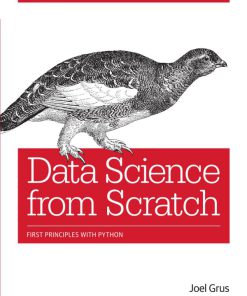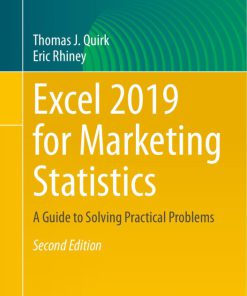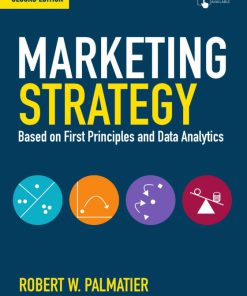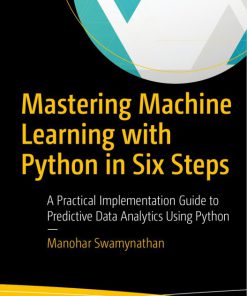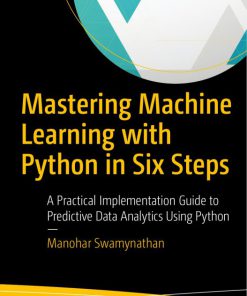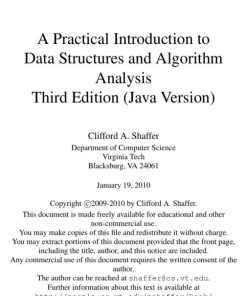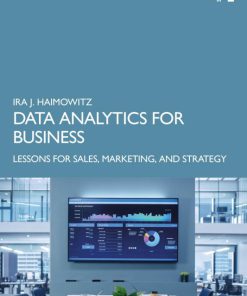Data Science for Marketing Analytics A practical guide to forming a killer marketing strategy through data analysis with Python 2nd Edition by Mirza Rahim Baig, Gururajan Govindan, Vishwesh Ravi Shrimal 9781800563889 180056388
$50.00 Original price was: $50.00.$25.00Current price is: $25.00.
Authors:Mirza Rahim Baig, Gururajan Govindan; Vishwesh Ravi Shrimali , Series:Management [586] , Author sort:Mirza Rahim Baig, Gururajan Govindan & Shrimali, Vishwesh Ravi , Languages:Languages:eng , Published:Published:Sep 2021 , Publisher:Packt Publishing
Data Science for Marketing Analytics A practical guide to forming a killer marketing strategy through data analysis with Python 2nd Edition by Mirza Rahim Baig, Gururajan Govindan, Vishwesh Ravi Shrimal – Ebook PDF Instant Download/Delivery.
9781800563889, 180056388
Full download Data Science for Marketing Analytics A practical guide to forming a killer marketing strategy through data analysis with Python 2nd Edition after payment
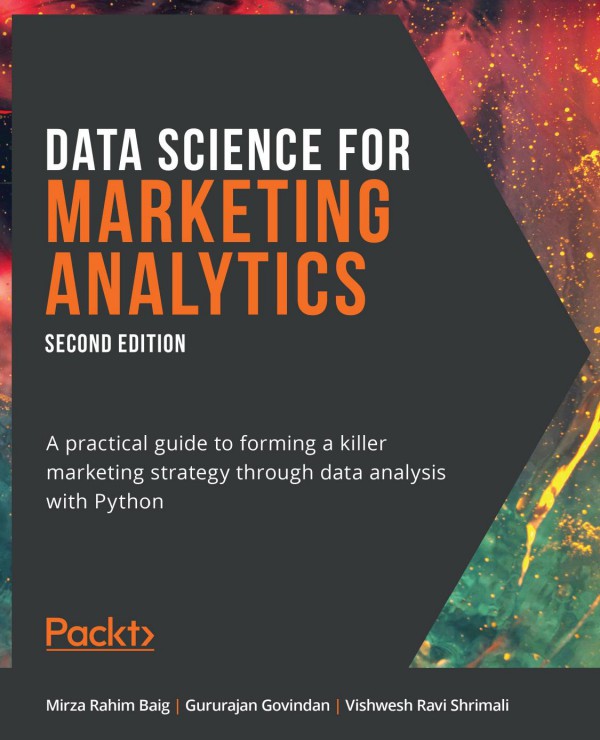
Product details:
ISBN 10: 180056388
ISBN 13: 9781800563889
Author: Mirza Rahim Baig, Gururajan Govindan; Vishwesh Ravi Shrimal
Turbocharge your marketing plans by making the leap from simple descriptive statistics in Excel to sophisticated predictive analytics with the Python programming language Key Features Use data analytics and machine learning in a sales and marketing context Gain insights from data to make better business decisions Build your experience and confidence with realistic hands-on practice Book Description Unleash the power of data to reach your marketing goals with this practical guide to data science for business. This book will help you get started on your journey to becoming a master of marketing analytics with Python. You’ll work with relevant datasets and build your practical skills by tackling engaging exercises and activities that simulate real-world market analysis projects. You’ll learn to think like a data scientist, build your problem-solving skills, and discover how to look at data in new ways to deliver business insights and make intelligent data-driven decisions. As well as learning how to clean, explore, and visualize data, you’ll implement machine learning algorithms and build models to make predictions. As you work through the book, you’ll use Python tools to analyze sales, visualize advertising data, predict revenue, address customer churn, and implement customer segmentation to understand behavior. By the end of this book, you’ll have the knowledge, skills, and confidence to implement data science and machine learning techniques to better understand your marketing data and improve your decision-making. What you will learn Load, clean, and explore sales and marketing data using pandas Form and test hypotheses using real data sets and analytics tools Visualize patterns in customer behavior using Matplotlib Use advanced machine learning models like random forest and SVM Use various unsupervised learning algorithms for customer segmentation Use supervised learning techniques for sales prediction Evaluate and compare different models to get the best outcomes Optimize models with hyperparameter tuning and SMOTE Who this book is for This marketing book is for anyone who wants to learn how to use Python for cutting-edge marketing analytics. Whether you’re a developer who wants to move into marketing, or a marketing analyst who wants to learn more sophisticated tools and techniques, this book will get you on the right path. Basic prior knowledge of Python and experience working with data will help you access this book more easily.
Data Science for Marketing Analytics A practical guide to forming a killer marketing strategy through data analysis with Python 2nd Table of contents:
1. Data Preparation and Cleaning
- Introduction
- Data Models and Structured Data
- pandas
- Importing and Exporting Data with pandas DataFrames
- Viewing and Inspecting Data in DataFrames
- Exercise 1.01: Loading Data Stored in a JSON File
- Exercise 1.02: Loading Data from Multiple Sources
- Structure of a pandas DataFrame and Series
- Data Manipulation
- Selecting and Filtering in pandas
- Creating DataFrames in Python
- Adding and Removing Attributes and Observations
- Combining Data
- Handling Missing Data
- Exercise 1.03: Combining DataFrames and Handling Missing Values
- Applying Functions and Operations on DataFrames
- Grouping Data
- Exercise 1.04: Applying Data Transformations
- Activity 1.01: Addressing Data Spilling
- Summary
2. Data Exploration and Visualization
- Introduction
- Identifying and Focusing on the Right Attributes
- The
groupby()Function - The
unique()Function - The
value_counts()Function - Exercise 2.01: Exploring the Attributes in Sales Data
- Fine-Tuning Generated Insights
- Selecting and Renaming Attributes
- Reshaping the Data
- Exercise 2.02: Calculating Conversion Ratios for Website Ads
- Pivot Tables
- Visualizing Data
- Exercise 2.03: Visualizing Data With pandas
- Visualization through Seaborn
- Visualization with Matplotlib
- Activity 2.01: Analyzing Advertisements
- Summary
3. Unsupervised Learning and Customer Segmentation
- Introduction
- Segmentation
- Exercise 3.01: Mall Customer Segmentation – Understanding the Data
- Approaches to Segmentation
- Traditional Segmentation Methods
- Exercise 3.02: Traditional Segmentation of Mall Customers
- Unsupervised Learning (Clustering) for Customer Segmentation
- Choosing Relevant Attributes (Segmentation Criteria)
- Standardizing Data
- Exercise 3.03: Standardizing Customer Data
- Calculating Distance
- Exercise 3.04: Calculating the Distance Between Customers
- K-Means Clustering
- Exercise 3.05: K-Means Clustering on Mall Customers
- Understanding and Describing the Clusters
- Activity 3.01: Bank Customer Segmentation for Loan Campaign
- Clustering with High-Dimensional Data
- Exercise 3.06: Dealing with High-Dimensional Data
- Activity 3.02: Bank Customer Segmentation with Multiple Features
- Summary
4. Evaluating and Choosing the Best Segmentation Approach
- Introduction
- Choosing the Number of Clusters
- Exercise 4.01: Data Staging and Visualization
- Simple Visual Inspection to Choose the Optimal Number of Clusters
- Exercise 4.02: Choosing the Number of Clusters Based on Visual Inspection
- The Elbow Method with Sum of Squared Errors
- Exercise 4.03: Determining the Number of Clusters Using the Elbow Method
- Activity 4.01: Optimizing a Luxury Clothing Brand’s Marketing Campaign Using Clustering
- More Clustering Techniques
- Mean-Shift Clustering
- Exercise 4.04: Mean-Shift Clustering on Mall Customers
- Benefits and Drawbacks of the Mean-Shift Technique
- k-modes and k-prototypes Clustering
- Exercise 4.05: Clustering Data Using the k-prototypes Method
- Evaluating Clustering
- Silhouette Score
- Exercise 4.06: Using Silhouette Score to Pick Optimal Number of Clusters
- Train and Test Split
- Exercise 4.07: Using a Train-Test Split to Evaluate Clustering Performance
- Activity 4.02: Evaluating Clustering on Customer Data
- The Role of Business in Cluster Evaluation
- Summary
People also search for Data Science for Marketing Analytics A practical guide to forming a killer marketing strategy through data analysis with Python 2nd :
data science for marketing analytics pdf download
data science for marketing analytics packt
what is data science in marketing
how is data science used in marketing
You may also like…
eBook PDF
A Practical Introduction to Data Structures And Algorithm Analysis 3rd Edition by Clifford Shaffer




